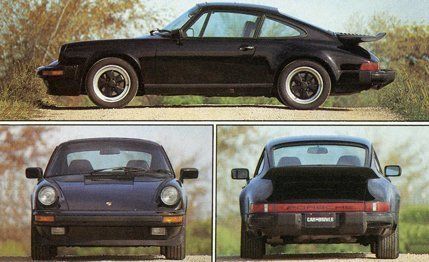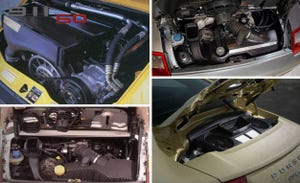From the February 1984 issue of Car and Driver.
It is the evil weevil, the rock-solid, steely-eyed grim reaper of sporting cars, the paragon of knife-edged incisiveness and buttoned-down insanity. More than any other factory-fresh passenger car available here today, the Porsche 911 Carrera is the absolute embodiment of clench-jawed, tightfisted, slit-eyed enthusiasm run amok, a car for making the landscape pass with explosive fluidity. Strange that a car so serious can bring such unadulterated joy, but there you are, sporting an enormous, cheek-splitting leer when you unstrap and step out. You devil, you.
The former 911SC thrilled the hardcore, adrenalin-addicted, pop-eyed performance toadies among us, offering a truly startling mix of performance and practicality, but it is no more. The Carrera replaces the 911SC, and it embodies all the same simultaneously outrageous and sensible qualities and more. The 911SC was fast, but the Carrera is a bullet. Firing from 0 to 60 mph in 5.3 seconds, an improvement of more than a full second, “shot out of a gun” covers it. And, although the 911SC returned a resolute 16 mpg on the EPA city cycle, the Carrera offers no less than a whopping 20 mpg.
Livability has even been improved somewhat in Porsche’s sporting but anachronistic interior. The car also goes down the road better, feeling more civil and less likely to bolt—all due to the Porsche penchant for constant improvement. The term “running changes” carries a double meaning in Porsche’s corner of West Germany.
This tough act to follow is located mostly under the rear deck lid, which carries the inspirational Carrera nameplate, earlier versions also having possessed well-deserved reputations for rocketry. Porsche offers no fewer than three choices of shell configurations for the 911 Carrera: coupe, Targa, and Cabriolet. In response to the growing hue and cry among its customers for greater individuality, the fully enclosed shell is available not only with the same relatively subdued lower bodywork worn by its airier brothers (which share a new front spoiler housing the fog lamps), but also with a larger air dam and the most instantly recognizable passenger-car aerodynamic device of all time, the Stuttgart whale tail. And, finally, the killer European Turbo treatment, meaning full-house bodywork and running gear, is available for everything but the engine.
Given the Carrera’s rousing performance, the current lack of a turbocharged offering is not really very disappointing, particularly in light of the accompanying fuel-economy boost. Newly stuffed into the 911’s rump are two additional tenths of a liter of displacement, bumping the single-overhead-cam flat six to 3.2 liters. At 95.0 millimeters, its bore remains the same, but its stroke has been elongated from 70.4 to 74.4 millimeters, matching the Turbo engine’s. Although Porsche is perpetually searching for improved mechanical efficiency, it is nonetheless a surprise that the Carrera’s engine is 80 percent new.
Reshaped pistons and combustion chambers within the air-cooled aluminum block and heads bring a modest compression-ratio increase, from 9.3:1 to 9.5:1. New tuned intake manifolding and Bosch Motronic fuel injection (very similar in principle to Porsche’s version on the four-cylinder 944) are fitted. The all-electronic Motronic system is replacing Bosch’s well-known mechanical K-Jetronic injection for a number of manufacturers because it produces extremely accurate operational tolerances for fuel mixture and ignition timing, prime contributors to efficiency. An overrun fuel shut-off minimizes unnecessary waste when the throttle is closed, although this may have been the cause of the part-throttle on-off power surges we noticed during testing. The new idle-speed regulator that is a part of the Motronic system also had a hard time keeping the engine running stably at no load, particularly when cold.
When it comes to pure “go,” however, the changes have pumped up an already healthy 172 bhp at 5500 rpm to a righteously distended 200 bhp at 5900 rpm. Maximum torque has risen from 175 pounds-feet at 4200 rpm to 185 pounds-feet at a lofty 4800 rpm, and the growling, thrumming flat six remains in the forefront of the world’s grunt-and-git, instant-forward rushers.
One of the reasons, of course, for the Carrera’s monumental acceleration capability is its out-back engine, which presses the 225/50VR-16 Goodyear NCTs into the pavement with all the vengeance that almost 60 percent of the Carrera’s 2760 pounds can provide. Handling lesser duties up front, 205/55VR-16 NCTs are fitted to 6.0-inch-wide alloys, which are an inch narrower than those at the rear.
The inequality of the Carrera’s front and rear footprints shows that Porsche is still heavily involved in offsetting the rear-engine layout’s inherent behavioral imbalance (read, strong trailing-throttle oversteer). The Carrera can and does demonstrate a will of its own, but its big-tired sense of right and wrong has produced a pretty remarkable taming of a once thoroughly unpredictable device.
This content is created and maintained by a third party, and imported onto this page to help users provide their email addresses. You may be able to find more information about this and similar content at piano.io









